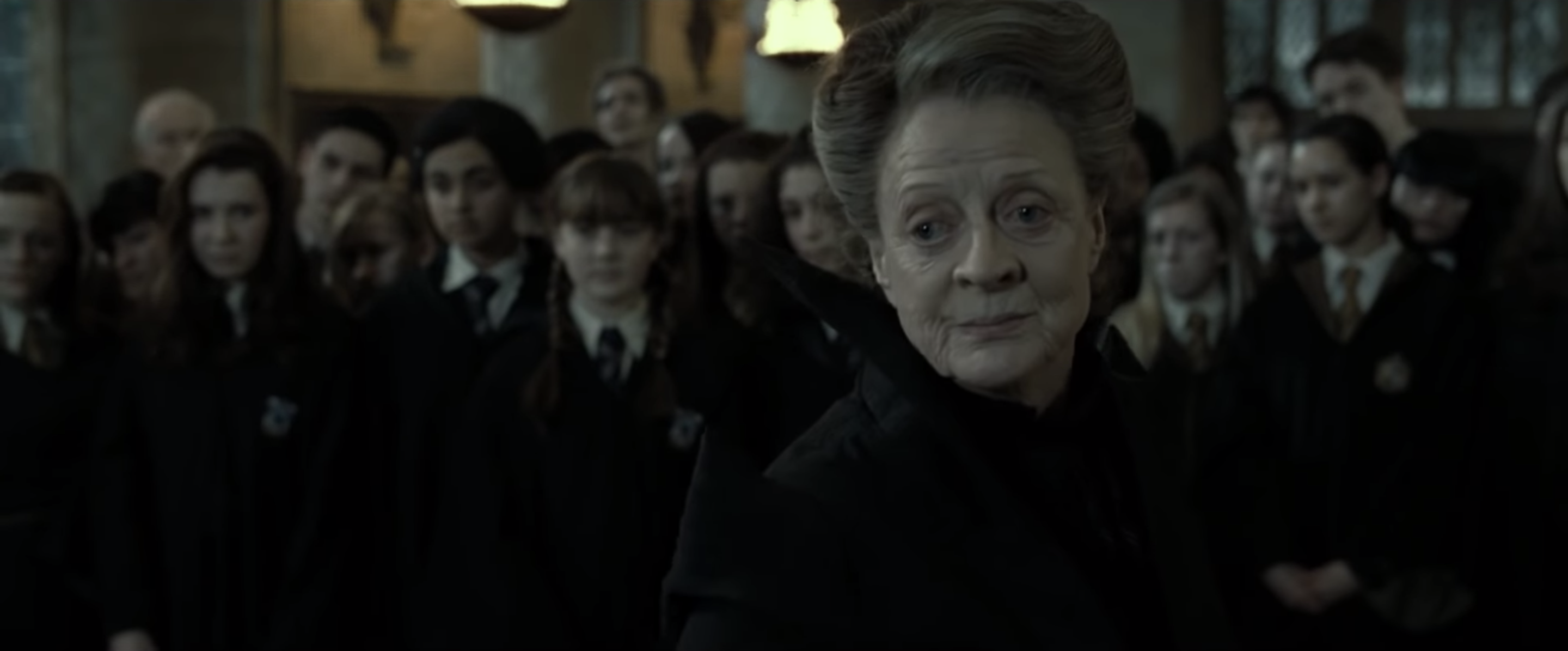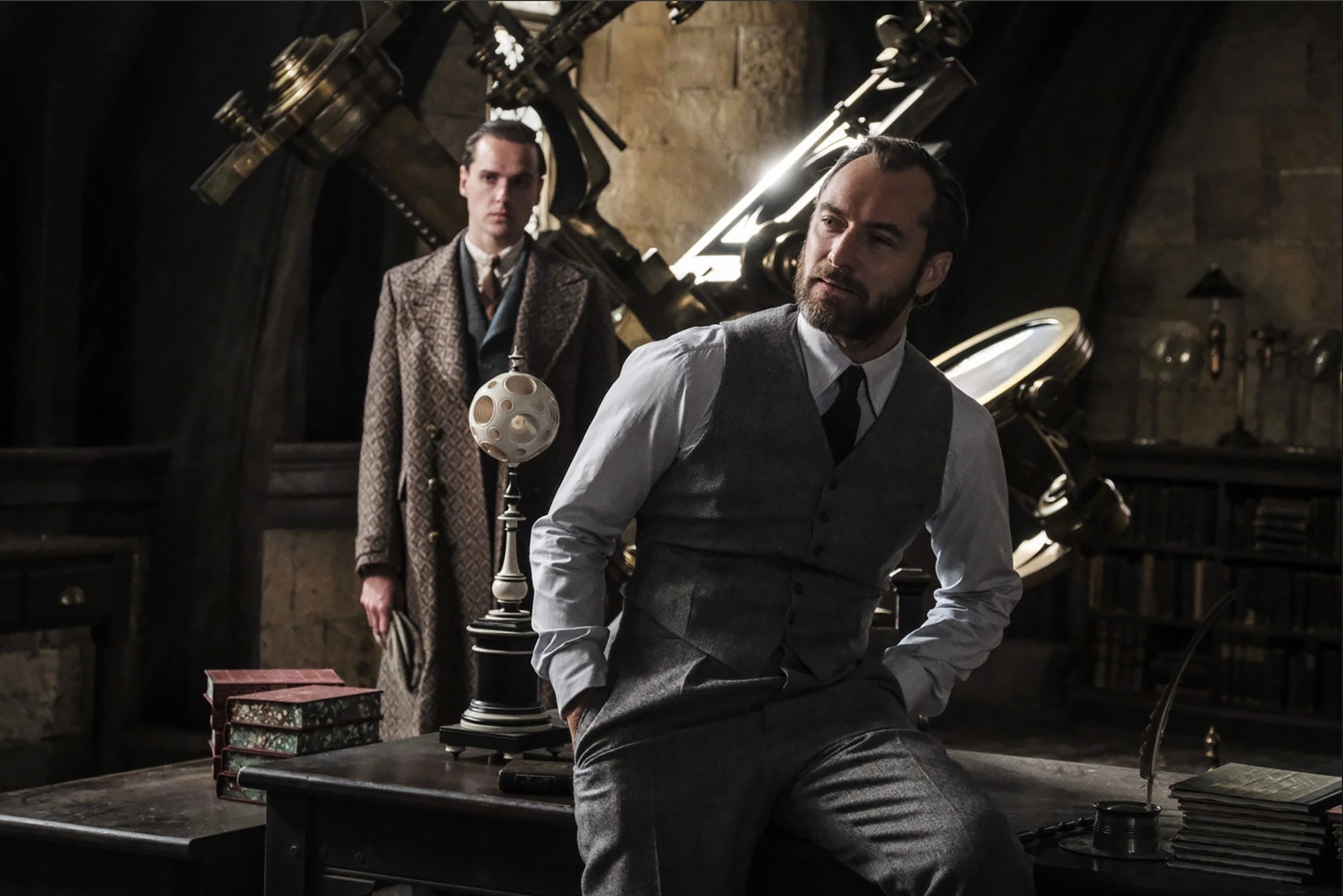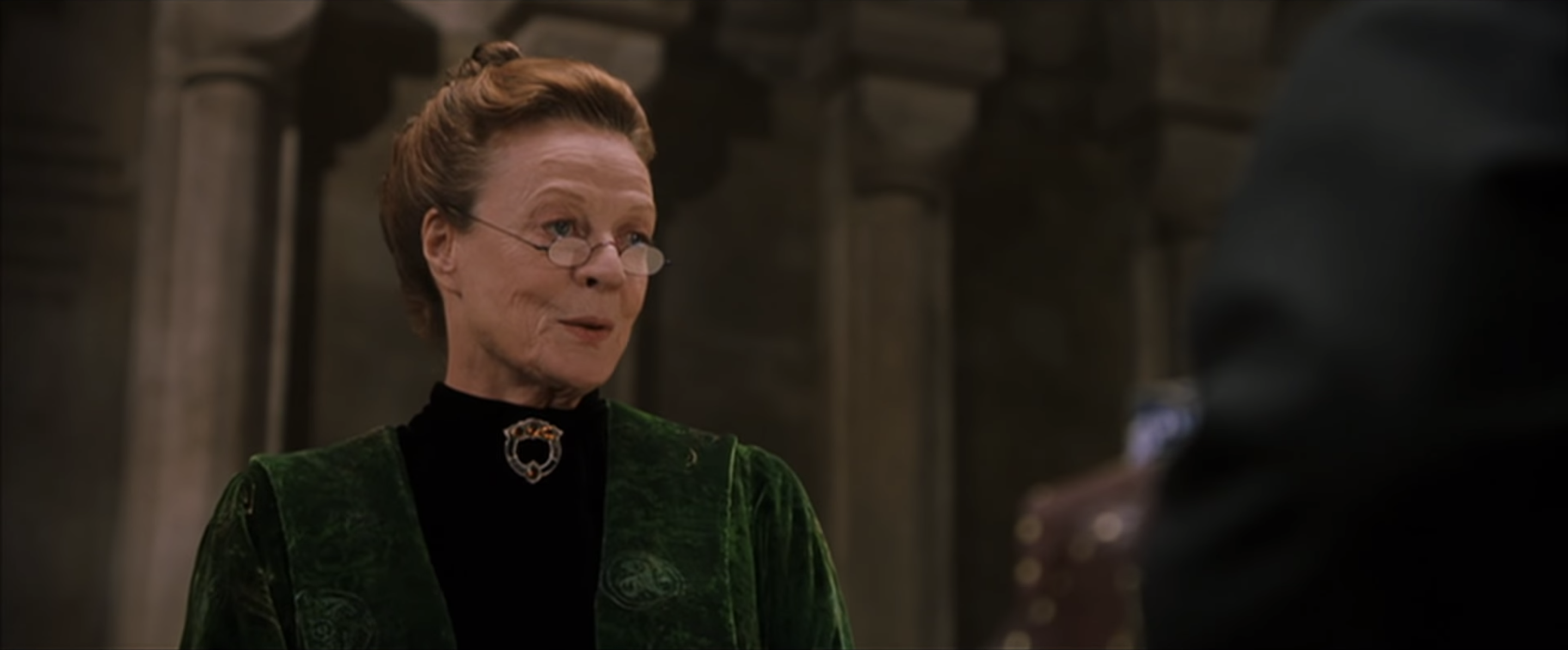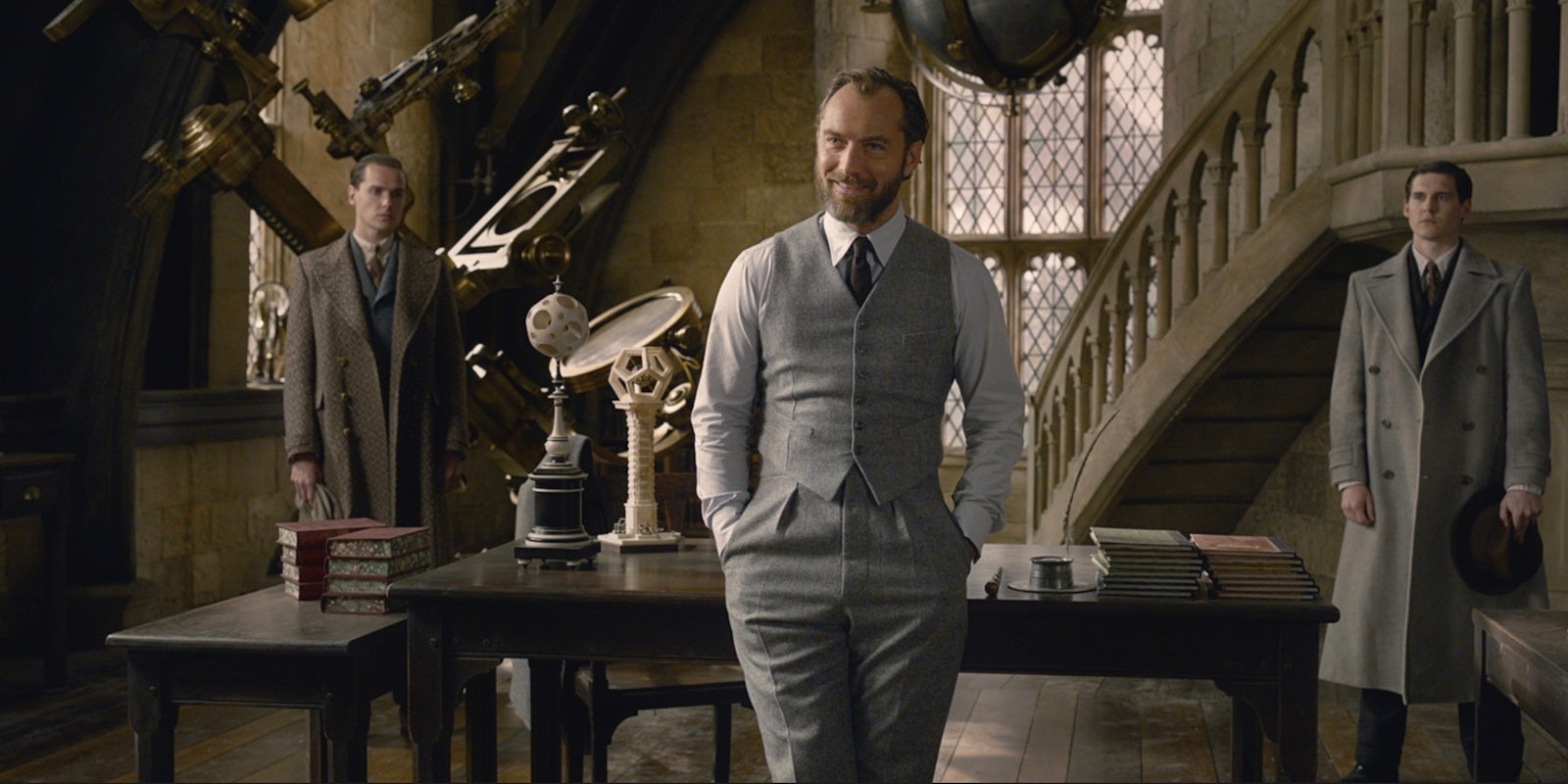Warning: This article contains spoilers for Fantastic Beasts: The Crimes of Grindelwald.
With a more Eurocentric setting and a return to Hogwarts School of Witchcraft and Wizardry, Fantastic Beasts: The Crimes of Grindelwald is much more referential to the iconic book and film series that preceded it. But in the process, the film gives us a head-scratcher of a cameo that not only doesn’t make sense, but it also throws a giant wrench into what we know about the canon of Harry Potter.
A good way into the movie, Theseus Scamander, Leta Lestrange, and a group of Aurors arrived at Hogwarts as curious students looked on. They were there to question Albus Dumbledore regarding the whereabouts of Newt Scamander and were serious enough to send out Dumbledore’s Defense Against the Dark Arts class into the corridor to do it. You can briefly see a professor outside the door, and the film leaves no question as to which one it is because she’s mentioned by name: Professor McGonagall.
McGonagall also appears later in a flashback to Leta and Newt’s time at Hogwarts. And in case you thought it could’ve been another Professor McGonagall at Hogwarts, the credits revealed that the character’s first name was Minerva, the same as Harry’s future Transfiguration professor. News of McGonagall’s cameo in The Crimes of Grindelwald made headlines even before the first fan screenings on Nov. 3 because a casting sheet confirmed that Fiona Glascott would be playing the character.
McGonagall doesn’t play any kind of role in The Crimes of Grindelwald, so her appearance is nothing more than a character cameo to further tie Harry Potter and Fantastic Beasts together. There’s just one problem: even in those brief moments, there’s absolutely nothing about it that works.
What we know about Minerva McGonagall

The main sticking point about why McGonagall’s cameo doesn’t work is a rather simple one compared to some of the film’s other sprawling issues. In 1927, the year in which The Crimes of Grindelwald takes place, McGonagall wouldn’t have just not been a Hogwarts professor—even less likely during Leta’s flashback that takes place at least a decade before that—she wouldn’t have even been born yet.
To be fair, J.K. Rowling has never explicitly said what year Professor McGonagall was born in (and only that her birthday was October 4), so we don’t know her birth year for sure. By using evidence from the Harry Potter series and McGonagall’s official Pottermore biography (as written by Rowling), fans determined that McGonagall was born in 1935.
How did they come to that date? First, you have to go to Order of the Phoenix. That book takes place during the 1995-1996 school year (or Harry’s fifth year) and features a scene in which Dolores Umbridge questions McGonagall about her qualifications.
“How long have you been teaching at Hogwarts?” Professor Umbridge asked.
“Thirty-nine years this December,” said Professor McGonagall brusquely, snapping her bag shut.
We might not know the exact day, but that scene takes place in 1995. Subtract 39 years, which would bring us to 1956. McGonagall’s arrival at Hogwarts in the Transfiguration Department came after she spent two years at the Department of Magical Law Enforcement almost straight out of Hogwarts, which would mean she graduated from Hogwarts in 1954. Given that she would’ve turned 18 the previous October, that puts her birth year at 1935.
Could McGonagall have potentially worked at Hogwarts in a different capacity before becoming the Transfiguration professor? Yes, but she’d have been among the first to have done so apart from Hagrid; the Hogwarts staff doesn’t really have something like a teaching assistant, so McGonagall would be the first. Plus, making McGonagall spend several decades as an assistant before getting to teach the subject herself to make the film’s timeline work would be an insult to her intelligence. (And she’s plenty smart; she was nearly sorted into Ravenclaw!)
The cameo complicates other aspects of Harry Potter canon

McGonagall’s early appearance as a Transfiguration professor at Hogwarts is a sticking point, but it also highlights another aspect of Harry Potter canon being wonky: Dumbledore’s tenure at Hogwarts.
We know from McGonagall’s biography (which also appears in the Pottermore ebook Short Stories from Hogwarts of Heroism, Hardship, and Dangerous Hobbies) that she had a particular talent for Transfiguration. That’s in part because she learned from the best. Dumbledore was her Transfiguration professor, and he even helped her become an Animagus (someone who can transform into an animal at will), something that’s incredibly difficult to do.
By the time we meet him in The Crimes of Grindelwald, Dumbledore is teaching Defense Against the Dark Arts instead of Transfiguration. One potential explanation is that Dumbledore took the position to make room for McGonagall, but that wouldn’t explain why he went back to teaching Transfiguration by the time that Tom Riddle opened the Chamber of Secrets during the 1942-1943 school year—another year determined by the main Harry Potter timeline.
“Only the Transfiguration teacher, Dumbledore, seemed to think Hagrid was innocent,” Riddle told Harry in Chamber of Secrets.
Then if that’s the case, where would McGonagall have gone when Dumbledore took back his teaching position? According to McGonagall’s biography, she remained at Hogwarts once she started teaching and eventually becoming the school’s headmistress, a role she still had during Harry Potter and the Cursed Child.
There is some leniency involved with the finagling of the timeline; for example, Rowling once said that McGonagall was 70 in a chat that occurred after the publication of Goblet of Fire, but that information has since been retconned (or is no longer considered canon). But what we do know doesn’t give us a lot of flexibility: Dumbledore was born in 1881, so her youngest, McGonagall could be around Newt’s age—who was born on Feb. 24, 1897, and would be about 30 by the time The Crimes of Grindelwald took place.
Even from a casual moviegoer standpoint, it’s still a waste of an appearance

For the fans who don’t obsess over the Harry Potter timeline, this might all feel like a matter of semantics. She pops in, pops out, and that’s it. Inconsequential, you might say.
And sure, that will likely work as an argument for some fans. Others might see a clear divide between the Harry Potter series and the Fantastic Beasts films even though they share a number of characters or surnames in it. But it’d probably work as a better argument if Warner Bros. wasn’t literally marketing The Crimes of Grindelwald based on the connection between Harry Potter and Fantastic Beasts. (Although granted, most of that is about Dumbledore himself versus the more spoiler-friendly McGonagall reveal.) There’s an emphasis on how connected the entire story is, so those inconsistencies in a timeline that has a lot of weight become harder to ignore.
The connection has always been there. Watch now to discover how #FantasticBeasts: The Crimes of Grindelwald is connected to the Harry Potter series and see it in theaters November 16. Get tickets now: https://t.co/JDjIHC6MsJ pic.twitter.com/IRjfcWEKUD
— Fantastic Beasts (@FantasticBeasts) November 8, 2018
Ultimately, the McGonagall cameo comes in two-fold. We still don’t know what the next three Fantastic Beasts films will play out, so there’s always a chance that McGonagall will have a larger role to play in the fight against Gellert Grindelwald. If she does, it almost certainly came at the expense of Rowling (who wrote the screenplay) meddling with the Harry Potter timeline—and almost certainly at the expense of McGonagall’s previously established character—to make it work.
But if all this ends up being is a cameo, it still came at the expense of McGonagall herself for nothing more than a wink and a nod for Harry Potter fans. And in its most generous interpretation, it’s a tepid wink that doesn’t serve any kind of purpose.

